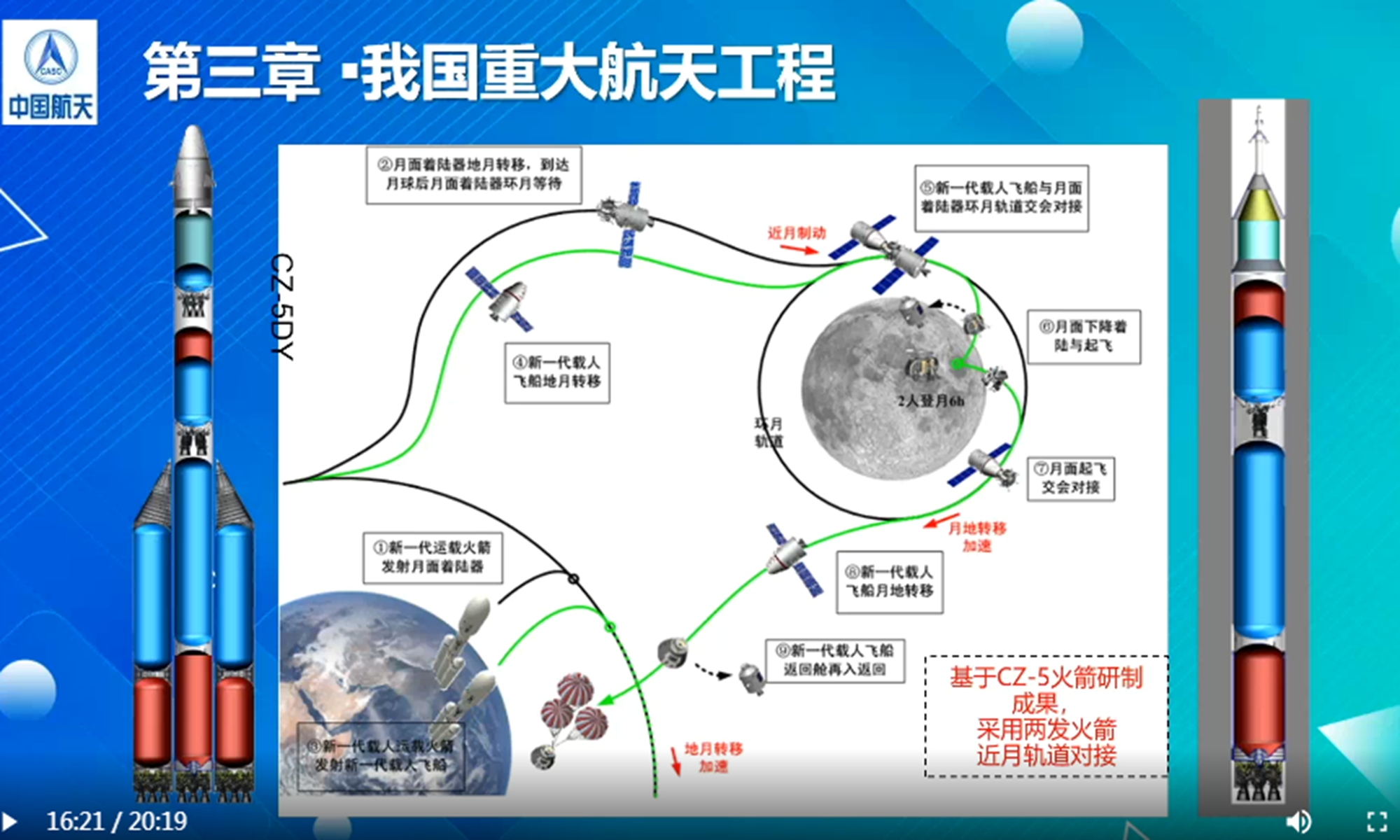
Leading Chinese rocket scientist Long Lehao unveils the ambitious manned lunar landing plan. Photo: screenshot of Long's speech draft
Leading Chinese rocket scientist Long Lehao has recently unveiled the country's ambitious manned lunar landing plan, which is expected to be carried out with two rocket launches by sending two taikonauts to the moon by around 2030. Long's comment offers a more detailed picture of the country's major breakthrough in space exploration.
Long, an academician of the Chinese Academy of Engineering and chief designer of Long March rockets, made the remarks at the 35th China Adolescents Science and Technology Innovation Contest, and a video of his speech went viral on social media late on Sunday night.
China is planning to use new variants of the Long March-5 launch vehicle - the strongest member of the Long March rocket family - to carry out the manned space launch missions, according to a slide Long used during his speech.
The 57-meter-long Long March-5 launch vehicle weighs 870 tons at launch and has a thrust of 1,000 tons. It is a large, two-stage rocket, capable of carrying a payload of 25 tons, equivalent to the weight of 16 cars, to low Earth orbit. It can carry a payload of 14 tons to geostationary transfer orbit, eight tons to Earth-moon transfer orbit, or five tons to Earth-Mars transfer orbit - more than twice the capacity of the current main Long March series rockets.
Long referred the new variant as Long March-5 DY, which is initials for the Chinese term of dengyue, the lunar landing.
Two rockets carrying a lunar lander and a next-generation manned spaceship will be launched for the mission, and the two parts of the spacecraft will rendezvous and dock in near-lunar orbit, before executing the landing process.
The two taikonauts are expected to work on the moon's surface for some six hours, according to Long's slide. However, there is no mention of a specific landing site.
Then, the new manned spaceship will take off from the moon and carry out another docking with the orbiting module before heading back to Earth.
When asked to confirm such new clues on China's manned lunar landing, sources with the China Academy of Launch Vehicle Technology, the major contractor of China's space projects and rocket manufacturer, said the project has yet to obtain state approval. But the sources did reveal that there will be a special press release on the matter during the China International Aviation and Aerospace exhibition, which is to be held in Zhuhai, South China's Guangdong Province in late September and early October.
Chinese space analysts reached by the Global Times on Monday said that such clues were very credible, as the two-rocket moon landing plan with Long March-5 variants, which they said would be immensely reliable and safe, is in line with the Chinese space sector's tradition of "standing firmly and fighting steadily."
Compared with the much-anticipated new heavy-lift launch vehicle, or the Long March-9, rumor has it that the variant of the Long March-5 is more likely to meet the timetable of 2030. Testing of the new rocket would normally take a long time and even longer when it comes to manned missions, where the safety of astronauts is paramount, Wang Ya'nan, chief editor of Beijing-based Aerospace Knowledge magazine, told the Global Times on Monday.
Space analysts saw similarities between China's plan and the one for US Blue Origin's initial Human Landing System mission, which requires three commercial launches for the manned lunar landing. And according to the US firm, it is a way to lower the risk of mission failure due to launch anomalies.
One early-stage Soviet Union crewed lunar mission also used two launches and docking, Pang Zhihao, a senior space expert, told the Global Times on Monday, underscoring China's manned lunar landing is of great feasibility.
From the slide with Long's speech, a Long March-5 rocket body is seen with an escape tower atop, which is similar to the one on top of China's current and only manned rocket Long March-2F.
Wang speculated that the development of a Long March-5 DY variant supporting manned flights would be a rather simple task for China's space sector within the time frame.




